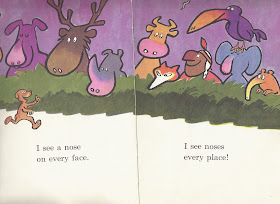Anyone who follows Native news or political dimensions of sports news knows that for the last year, there has been an increase in the media coverage of the use of Native imagery by sports teams. Some news outlets have decided to stop using some team names in their reporting, and many are critical of Dan Snyder's misguided efforts to garner support from Native people for his entrenched use of "Redskins" as the name of his team.
In 2008, Stephanie Fryberg's research provided empirical data on the damage mascot imagery does to the self efficacy of Native students. Her research was of such import that the American Psychological Association issued statements calling for an end to their use. If her study was replicated with younger children, using images they see in picture books and fiction they read or are asked to read in school, I think the results would be the same.
I am hopeful that increased attention to mascots like the one used by the Washington DC pro football team, or the one used by the Cleveland pro baseball team will bring an end to their use of that imagery. With that increased awareness, I hope that Native and non-Native parents look with informed eyes at images of Native peoples in the books their children read for pleasure or study. The images that adults embrace are images they've seen since they were children. Some of those images were in movies, some on items in the grocery store, and many were in children's books.
On October 19, 2013, I wrote about the Washington DC pro football team and shared images from children's books that are similar to its mascot. Today, I'm showing images that resemble those of Cleveland's mascot.
Here is the "Chief Wahoo" currently in use alongside the image used from 1946 to 1950.
 |
| Source: Indian Country Today, June 29, 2013 |
Here's a page from the 1952 Little Golden Book of Disney's Peter Pan. Is the book on your shelf? Is the CD or DVD amongst your collection?
Those are older books, but I urge you to look on your shelves. If you held on to books from your childhood, the titles I pointed to above (or others with similar imagery) may be among them. You can do one of two things with them. Put them away and use them later with your child when you teach him or her about stereotyping, or, if you're not attached to the book for sentimental reasons, throw it out.
Here's some images from more recent books. You'll find a lot of them if you look in books about Thanksgiving.
This image is from More Snacks! A Thanksgiving Play. It is in the Ant Hill series of Ready-To-Read books published by Aladdin. Written by Joan Holub, illustrated by Will Terry, it came out in 2006.
Here's a character from the popular Amelia Bedelia books. This image is from Amelia Bedlia Talks Turkey by Herman Parish, illustrations by Lynn Sweat. It was published in 2008 by HarperCollins.
Such imagery is also in newer movies made for children, like last year's Free Birds. Here's turkey Indians from it:
The images I'm sharing in this post are a sample. You will find others. Too many others. They are not harmless. They reduce American Indians to detribalized caricatures or props in stories that misinform readers. They affirm stereotypical ideas, and are part of what I believe causes Native students to disengage from school.
As I noted above, I hope that the increased awareness of the harm in mascots used by sports teams can be brought to bear on children's books and media.
If you are getting rid of those books, replace them with better materials! At the top right of this page, you'll see links to lists of books that I recommend. Order them for your home library, and ask your library to get them, too. Give them as end-of-the-year gifts to your child's teachers!
Let's work together and get rid of stereotypical imagery of American Indians, on and off the playing field.







Have you read any, "Hank the Cowdog"? There is one that depict the coyotes as Native Americans, and they are getting drunk and acting as criminals. It is very disturbing to me as a Native American. I read it to my third graders one year and tried to protest, but it didn't matter to anyone.
ReplyDeleteYes, I took a look a few years ago. Here's the link to it:
ReplyDeletehttp://americanindiansinchildrensliterature.blogspot.com/2009/06/hank-cowdog.html
Having been in many school libraries that have these outdated books, I have begun o take an approach that not only teaches, but promotes better more contemporary ways of thinking about books about Native Peoples.
ReplyDeleteEach time I go into a school library, I am armed with one or two well written books about Native Americans, usually written by Native authors. I peruse the section on Native history, usually find a book or two like the ones you've shown in this posting, and then I go find the school librarian.
Explaining why one book is a better fit for young readers is the easy part. I produce the well-written books, and trade them out for the older, outdated and misdirected books.
Kudos to all the librarians, I have not been turned down yet! Once they can see the books in comparison, they understand the differences between inaccurate outdated books and those with more contemporary and accurate books.
I usually give them the AICL website for further information, and I can tell you the only difficult part of this is wondering whether the librarians keep looking for information on the books!
Jane Harstad, D.Ed